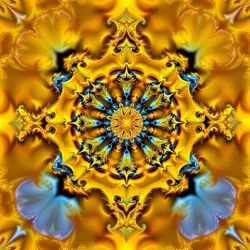Fractal Symphony: The Art of Recursive Beauty
The Fractal Symphony is a collection of recursive patterns that showcase the inherent beauty of mathematics through artistic expression. This concept marries fractal geometry with visual and auditory arts, creating pieces that are both aesthetically pleasing and mathematically intriguing. Fractal Symphony finds applications in various fields, including computer graphics, music composition, and scientific modeling.

An intricate display of fractal patterns from the Fractal Symphony.
Origins and Development
The idea behind Fractal Symphony arose in the late 20th century when artists and mathematicians began to appreciate the aesthetic potential of fractal geometry. The term "Fractal Symphony" was coined by the visionary artist Aurelia Mandel, who sought to capture the rhythmic and melodic qualities of fractal patterns.
Mathematicians such as Johannes Fractalium were instrumental in laying the groundwork for these explorations by developing the mathematical frameworks that allow for the creation of fractals. These pioneers inspired a new generation of artists and scientists to explore the artistic potential of recursive patterns.
Characteristics
Recursive Patterns
Fractals are distinguished by their self-similar and recursive nature, where a simple pattern repeats itself at various scales. This property allows fractals to create complex structures from simple mathematical formulas, such as the Mandelbox and Julia Set Variations, both of which are integral to the Fractal Symphony.
Artistic Applications
Fractal Symphony has inspired artists to push the boundaries of creativity. By employing fractal algorithms, artists generate intricate designs that challenge conventional notions of symmetry and form. This approach has given rise to Fractal Baroquism, blending the opulence of baroque art with the infinite nature of fractals.
Musical Elements
In music, fractals are used to compose complex, evolving soundscapes. Composers use fractal algorithms to craft musical compositions that mimic the unpredictability and harmony found in natural patterns. This has led to the creation of unique auditory experiences that are both structured and organic.
Impact and Applications
Visual Arts
In visual arts, fractals are employed to create stunning works that convey depth and complexity. The Grand Baroque Textures Exhibition prominently features pieces influenced by the Fractal Symphony, showcasing the fusion of mathematical precision with artistic expression.
Scientific Visualization
Fractals are invaluable in scientific visualization, particularly in modeling natural phenomena such as coastlines, mountain ranges, and biological structures. Their ability to represent irregular and complex shapes makes them crucial in fields like computer graphics and data visualization.
Future Prospects
As technology advances, the potential applications of fractals continue to expand, especially in areas like fractal holography and virtual reality. These innovations offer new ways to experience and interact with digital content, opening up endless possibilities for artistic and scientific exploration.
See Also
The Fractal Symphony represents a harmonious blend of mathematical theory and artistic creativity, offering a window into the infinite possibilities of recursive beauty. As its influence grows, the Fractal Symphony continues to captivate and inspire, challenging our understanding of art, science, and the intricate patterns that shape our world.